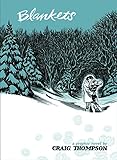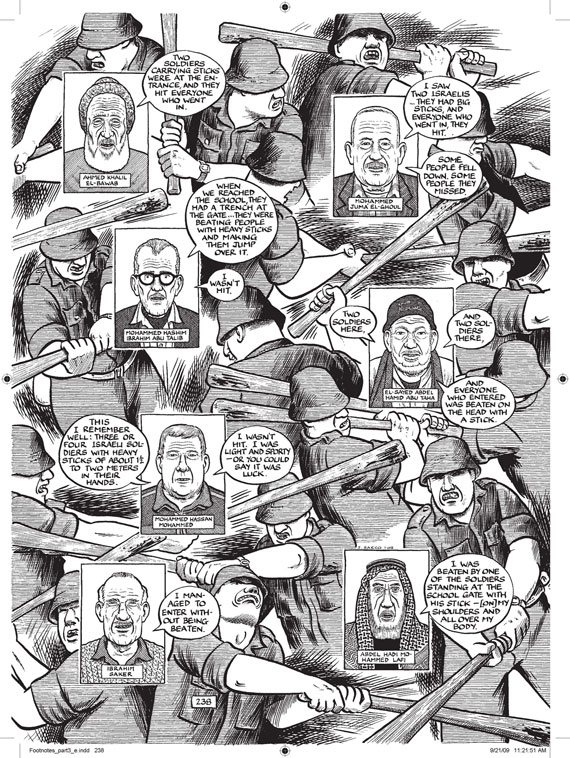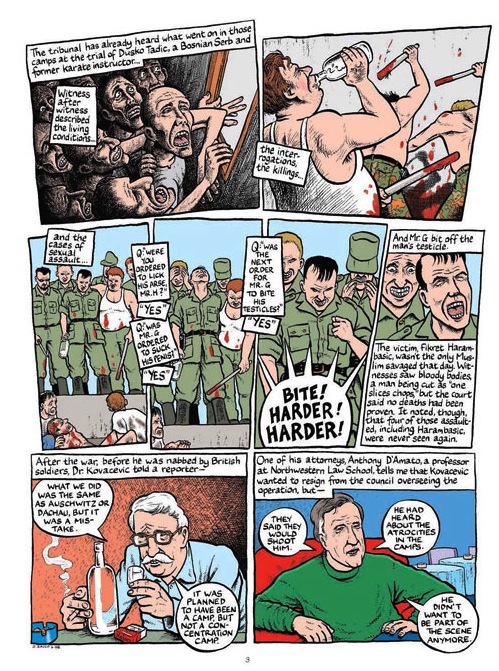
 The following interview with Joe Sacco, the comics journalist best-known for his accounts of the war in Bosnia and life in the Palestinian territories, could be called “How to Draw an Atrocity.” His work is layered in well-earned details. Safe Area: Goražde depicts a besieged town sealed off from the world by the Balkan conflict. In the midst of a civil war, one young woman asks Sacco to get her some nice jeans from Sarajevo. In what is so far his magnum opus, Footnotes in Gaza, Sacco researched a forgotten massacre of Palestinian civilians during the Suez War in 1956. There is no photographic evidence of the massacre, and so Sacco was left illustrating the testimonies of older Palestinians, filling in the physical details based on his frequent trips to the Middle East’s Soweto. It’s not clear if he broke any unwritten rules concerning the way an atrocity should be depicted. He may be inventing rules of his own.
The following interview with Joe Sacco, the comics journalist best-known for his accounts of the war in Bosnia and life in the Palestinian territories, could be called “How to Draw an Atrocity.” His work is layered in well-earned details. Safe Area: Goražde depicts a besieged town sealed off from the world by the Balkan conflict. In the midst of a civil war, one young woman asks Sacco to get her some nice jeans from Sarajevo. In what is so far his magnum opus, Footnotes in Gaza, Sacco researched a forgotten massacre of Palestinian civilians during the Suez War in 1956. There is no photographic evidence of the massacre, and so Sacco was left illustrating the testimonies of older Palestinians, filling in the physical details based on his frequent trips to the Middle East’s Soweto. It’s not clear if he broke any unwritten rules concerning the way an atrocity should be depicted. He may be inventing rules of his own.
 In his new collection of short pieces, Journalism, he chronicles poverty in rural India, the training of Iraqi security forces, and the recent wave of African immigration to Sacco’s native Malta. (Sacco was born in Malta and remains a citizen of the island nation, but he spent his childhood in Australia and the U.S. and has mostly lived here for about 40 years.) I met Sacco on an August afternoon in his studio in his house in Portland. We began by discussing one of the stories in Journalism, “Trauma on Loan,” about two ordinary Iraqis who were tortured by American soldiers during the early days of the Iraq War. I pointed to one moment in the piece in which Sacco illustrates the story of one of the Iraqis with a point-of-view shot from the perspective of an American soldier.
In his new collection of short pieces, Journalism, he chronicles poverty in rural India, the training of Iraqi security forces, and the recent wave of African immigration to Sacco’s native Malta. (Sacco was born in Malta and remains a citizen of the island nation, but he spent his childhood in Australia and the U.S. and has mostly lived here for about 40 years.) I met Sacco on an August afternoon in his studio in his house in Portland. We began by discussing one of the stories in Journalism, “Trauma on Loan,” about two ordinary Iraqis who were tortured by American soldiers during the early days of the Iraq War. I pointed to one moment in the piece in which Sacco illustrates the story of one of the Iraqis with a point-of-view shot from the perspective of an American soldier.
The Millions: This is something that’s very hard to do in prose journalism. If a victim is telling a story it’s very hard to see it from the point of view of the victimizer. But you, as a comics journalist, can create something like this image.
Joe Sacco: The whole point is to be able to recreate things from different perspectives. I have to give myself that freedom. I’ve always said drawing is a subjective act. Does that absolve me from an accusation of manipulation? Perhaps not in some people’s eyes. You could tone it down, I guess. I could have drawn it in a different way. That’s true. But I chose to draw it this way.
The words themselves are accurate quotes. It says, “One of the detainees was in front. His actions were like a dog’s.” I’m not going to draw a guy who’s just surly, holding back…I have a dog. And the way a dog acts, it begs and is excited. I’m just trying to visualize that.
TM: In your last Comics Journal interview you said that there has always been a grotesque quality in your work. There is some sense of the grotesque, of the strange, of the uncanny in your figures, even though you have this very journalistic desire to show something that’s real. How does this problem manifest itself when you are drawing sympathetic people like these two [Iraqi] gentlemen and this less-than-sympathetic American soldier?

 JS: When I’ve said that I’ve tended toward the grotesque…what [I’m] saying is that I can never draw as beautifully as Craig Thompson (Habibi, Blankets). It’s just not in my hand. Even people who look good in real life never look good the way I draw them, not through any desire to make them grotesque but through a certain inability. I just don’t draw beautiful people beautifully. I would rather draw a good-looking woman as a good-looking woman, but I don’t have quite that ability to get it right. So my stuff tends in that direction anyway.
JS: When I’ve said that I’ve tended toward the grotesque…what [I’m] saying is that I can never draw as beautifully as Craig Thompson (Habibi, Blankets). It’s just not in my hand. Even people who look good in real life never look good the way I draw them, not through any desire to make them grotesque but through a certain inability. I just don’t draw beautiful people beautifully. I would rather draw a good-looking woman as a good-looking woman, but I don’t have quite that ability to get it right. So my stuff tends in that direction anyway.
If I’m going to draw some American soldiers taunting an Iraqi prisoner, I’m not going to make their expressions neutral. If you’re taunting someone, you’re taunting someone. And if you’re getting a kick out of it, you’re getting a kick out of it. The action itself is grotesque. The action of doing that is grotesque. And so that’s reflected in the drawing.
TM: There’s a claim that a good novelist has sympathy for all of his characters. [Do you have any such sympathy] when you draw these bullies?
JS: No. Not always. When you’re drawing you have a lot of characters who don’t have speaking parts. A novelist generally deals with a set amount of characters. And you can flesh those characters out. But [when] a novelist is describing getting on a train with a hundred people…[he or she’s] not fleshing out all of those characters. I have to draw them. So it presents a problem.
I have a difficult time drawing the eyes of people when they’re committing atrocious acts. It’s not like I don’t do it if I’m sure they’re sadistic. In this case I probably could have done it. Because in this case, [with] a soldier taunting someone, I can imagine their sadism and I can understand a sadist’s face, or I have the pretense of thinking I can understand a sadist’s face…
Think of it as acting. Think of it as [being] a film director, because, ultimately, that’s what you’re doing. You’re saying to yourself, “How is this person going to be looking if you’re an actor?” And every time you draw something, much like acting, you have to get into the role on some level of what that person is thinking or feeling. It’s easier to draw a sadist. The more difficult thing is to draw ordinary people doing atrocious things. Someone throwing a cigarette to taunt someone is a sadist. Or anyway that’s a sadistic act. And maybe that person isn’t always a sadist. [But] I’m going to draw a sadistic expression.
I had more trouble in the book Footnotes in Gaza with this sort of thing because I didn’t think all those people [Israeli soldiers] were sadists. I think there were sadists among them. But to me, this is a case, generally speaking, of ordinary human beings killing other human beings and perhaps not even out of a sense of hatred.
I couldn’t understand the psychology of doing what they were doing. As I was drawing I didn’t draw their faces exactly because I didn’t want to presuppose their intentions or their psychological state, which is why I very seldom [draw] their eyes.
Doing [Footnotes in Gaza] in particular is when I realized I didn’t understand how to draw certain things because I didn’t understand the psychology of the moment. It’s easier to understand fear. I can draw fear. I can draw sadism. But an ordinary person doing something like this is a very difficult thing to understand. I’m not going to pretend I understand it. It was easier to hide the face.
TM: But when you are giving this level of individuality to these Israeli soldiers, these Serbian genocidal killers, these American soldiers, does that allow you to imagine a kind of individual intelligence behind them that you just described to me?
JS: I think about it all the time. I think, “This one’s gesture is going to be more aggressive. This one’s going to be aggressive but not as aggressive.” …There’s a range. Not all of them are the same. They’re not all going to behave the same way. But then you think, “Well their officers are there and they’re being told to do this. Are they going to do it?” There might be a moment too when you’re doing it and these people [victims] might be sniveling and crawling in front of you and it helps you, because they’re humiliating themselves which makes you despise them. These are things I think about. But they’re not necessarily things I understand. I’m going off in a different direction with my new work because of these very questions.
TM: What’s this new direction?
JS: I’m interested in psychology and neuroscience and understanding human nature. It [came from] the problems I had doing this [Footnotes in Gaza]…With journalism I can explain [events]. I can even explain the history behind [them]. What I couldn’t explain to myself is the individual relationship to those events. That’s why I’m telling you I had a hard time drawing this stuff.
TM: What are you working on now that is dealing with this new direction? I don’t know if you’re comfortable announcing a new project.
JS: It’s hard to describe what I’m trying to do. I want to grapple with the concept of human nature, how we develop societies, our relationship to authority, starting from the primate level on. [It] sounds like a huge huge undertaking and it is and I don’t know if I’ll be able to figure it out. I don’t know if it will make for good comics necessarily. I just want to concentrate on this story about Mesopotamia and the development of the first cities — even before the first cities — of how hierarchy developed, how central authority developed, how our role as people under central authority, this relationship, developed. It all interests me. That is enough. And that could go on for years. And I’ve been interviewing archaeologists in different places…
 TM: Your books are very easy to read. And many of your contemporaries have moved to making comics difficult. Art Spiegelman, when he made his book about 9/11, In the Shadow of No Towers, designed the format so you don’t know where your eye is supposed to go at any given point. Chris Ware does that a lot as well. You have a linear method. When I read your books I usually feel I know where my eye is supposed to go.
TM: Your books are very easy to read. And many of your contemporaries have moved to making comics difficult. Art Spiegelman, when he made his book about 9/11, In the Shadow of No Towers, designed the format so you don’t know where your eye is supposed to go at any given point. Chris Ware does that a lot as well. You have a linear method. When I read your books I usually feel I know where my eye is supposed to go.
JS: Well if you don’t it’s very intentional. There are cases where you are supposed to be a little confused about how to read things.
TM: Did your journalism training make you think you had to make your work as clear as possible?
JS: I think so. I think that’s it. Journalism is a constraint, on some level. I don’t even like drawing representational-y very much. I don’t think I’m particularly good at it to be honest. It never feels completely comfortable. And I’m not even sure if I drew in a cartoon-y fashion if that would be comfortable.
 This is not your New York Times kind of journalism which is often really boring. The difference between reading the standard New York Times writer — there are some exceptions — and someone like Robert Fisk of The Independent is like night and day. I feel like I’m there with Fisk, you know. That’s the tradition I’m more interested in journalistically speaking. Yes, I want the situation to be [as] clear as much as possible because I also think often the subject matter itself is difficult for people. It’s not pleasant. I don’t need tricks. I don’t want tricks. It’s mostly pretty standard. You’ll see in my first journalistic work Palestine that there were a lot of different angles and all that. That was fun to draw, [but] it didn’t necessarily help the story along.
This is not your New York Times kind of journalism which is often really boring. The difference between reading the standard New York Times writer — there are some exceptions — and someone like Robert Fisk of The Independent is like night and day. I feel like I’m there with Fisk, you know. That’s the tradition I’m more interested in journalistically speaking. Yes, I want the situation to be [as] clear as much as possible because I also think often the subject matter itself is difficult for people. It’s not pleasant. I don’t need tricks. I don’t want tricks. It’s mostly pretty standard. You’ll see in my first journalistic work Palestine that there were a lot of different angles and all that. That was fun to draw, [but] it didn’t necessarily help the story along.
TM: I was thinking about the power of the short form versus the long form. I found Footnotes in Gaza impossible to read in one sitting. I felt reading it that there was a circularity to the narrative in which we kept returning to the same problem and that [this circularity] is reflective of the subject matter. So when you see the atrocities in Footnotes in Gaza they stop having the same shock after awhile. But with something like this, “The War Crimes Trials,” which is a total of six pages, there are just these few panels that have, for me at least, far greater shock.
JS: To me that’s very subjective because I’ve heard many people say very different things about Footnotes in Gaza from what you just said as far as its power to shock them. But I’m not even sure that I’m going for shock. I’m just trying to represent things in a way, even in a dull way somehow. I’m not Joe Kubert, may he rest in peace. I’m not going to draw everything spectacularly with explosions and people flying though they look like they’re in a ballet somehow. That’s not how I think of things.
If you look at the scene that you’re pointing to, maybe some of its power comes from the fact that you’re not seeing anyone getting his testicle bitten off. You have to imagine what it’s like. Would it have been more shocking if I had shown it? Maybe on some level. But it would have been cheaper and not as effective. You can be shocking and also not be effective.
TM: When you have to draw these horrors, does it affect other elements of your life?
I was miserable. And I don’t want to do it again, really. There are reasons for going off and doing other projects that aren’t journalistic in the way I’ve done them before. Partly I want to learn something new. I feel like I’ve gone about as far as I can go looking at these sorts of incidents. Which aren’t the same incidents. They’re very different kinds of things. But when you’re involved in [them] they begin to look the same. That’s one of the reasons in that Journalism book I tried to do something different than massacres. I wanted to do [things] about human migration or poverty. And even those are tough things to do. But they’re physically not as hard as drawing dead bodies over and over.
TM: I don’t know if you’ve been told this but you don’t have an identifiable accent. I would have no idea where you’re from unless I was told you were from Malta. It’s not clearly American. It’s not clearly Australian. It’s not clearly anything. Now you mention that you feel some responsibility as a Maltese citizen when you write about the plight of African immigrants in Malta. And that you feel some responsibility if not as an American citizen than as an American taxpayer for the American government’s support of Israel’s actions in the Palestinian territories. But in some ways — I don’t know if this is insulting — you are a man without a country.
JS: Why is that insulting?
TM: I don’t know. I’m telling you that in some way you have no fixed background. I don’t know if that helps you when you travel.
JS: Culturally, I feel more American than [anything else]. This is where I spent a lot of my time. I also have a cultural upbringing that is Maltese. So I’m not going to shake either of those things. Nor do I want to. You are who you are. I’m relatively comfortable with who I am. I don’t feel vested in any particular nationality or in any national project. I live here because I live here and I’m comfortable here. I like being here and there are things I like about living in the United States. But I don’t feel I owe anything to the United States, or to Malta or to Europe or Australia. I might feel more responsibility based on where I am for what the United States does or what happens in Malta on some level.
[As for] Bosnia…I don’t think I have a dog in any fight, in a certain way. But I certainly don’t have a dog in that fight. It’s just humans and other humans.
This transcript represents selections from a 90-minute interview. Special thanks to Eric Reynolds of Fantagraphics for assisting in this interview’s preparation.











